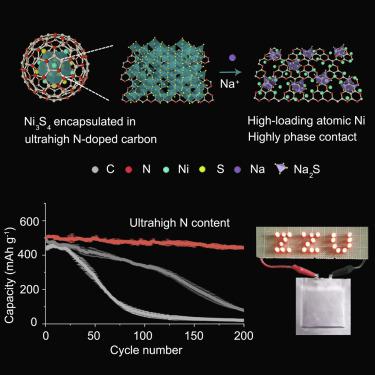Chem ( IF 19.1 ) Pub Date : 2021-07-12 , DOI: 10.1016/j.chempr.2021.06.008 Keming Song 1 , Jiefei Liu 1 , Hongliu Dai 2 , Yong Zhao 3 , Shuhui Sun 2 , Jiyu Zhang 1 , Changdong Qin 4 , Pengfei Yan 4 , Fengqi Guo 1 , Caiyun Wang 3 , Yuliang Cao 5 , Shunfang Li 6 , Weihua Chen 1

|
Building phase interface with enough solid-phase contact is of great importance for improving chemical reaction kinetics and depth. High dispersion of electrode materials, especially at the atomic-level, are known for high interface contact, yet their potential application in batteries is restricted due to low loading. Herein, the atomically dispersed metal Ni (Ni in Ni–N–C is 54.9 wt %) with high loading was achieved by ultrahigh N-doping carbon (N/N–C:29.5 wt %) during the discharging process of nickel sulfide, leading to good reversibility and high-capacity maintenance owing to ultrahigh phase contact during long cycling for sodium-ion batteries. It delivers a stable cycling life (0.061% capacity decay per cycle) compared with the poor cyclability (0.418%) for the Ni agglomeration electrode with lower N-doping. The assembled pouch cells achieve robust stability (92.1% after 50 cycles). DFT calculations reveal that ultrahigh N-doping and electrochemically formed Na2S can provide thermally stable Na2S/Ni/NC structures, inhibiting Ni agglomeration during cycling.
中文翻译:

超高氮掺杂碳诱导的原子分散镍可实现稳定的钠储存
建立具有足够固相接触的相界面对于改善化学反应动力学和深度非常重要。电极材料的高分散性,尤其是在原子级,以高界面接触而闻名,但由于低负载,它们在电池中的潜在应用受到限制。在此,在硫化镍放电过程中,通过超高 N 掺杂碳(N/N-C:29.5 wt %)实现了具有高负载量的原子分散金属 Ni(Ni-N-C 中的 Ni 为 54.9 wt %),由于钠离子电池在长循环期间的超高相接触,导致良好的可逆性和高容量维持。与具有较低 N 掺杂的 Ni 团聚电极较差的循环性能 (0.418%) 相比,它提供了稳定的循环寿命(每个循环容量衰减 0.061%)。组装的软包电池实现了强大的稳定性(50 次循环后达到 92.1%)。DFT 计算表明超高 N 掺杂和电化学形成的 Na2 S 可以提供热稳定的 Na 2 S/Ni/NC 结构,抑制循环过程中 Ni 的团聚。











































 京公网安备 11010802027423号
京公网安备 11010802027423号